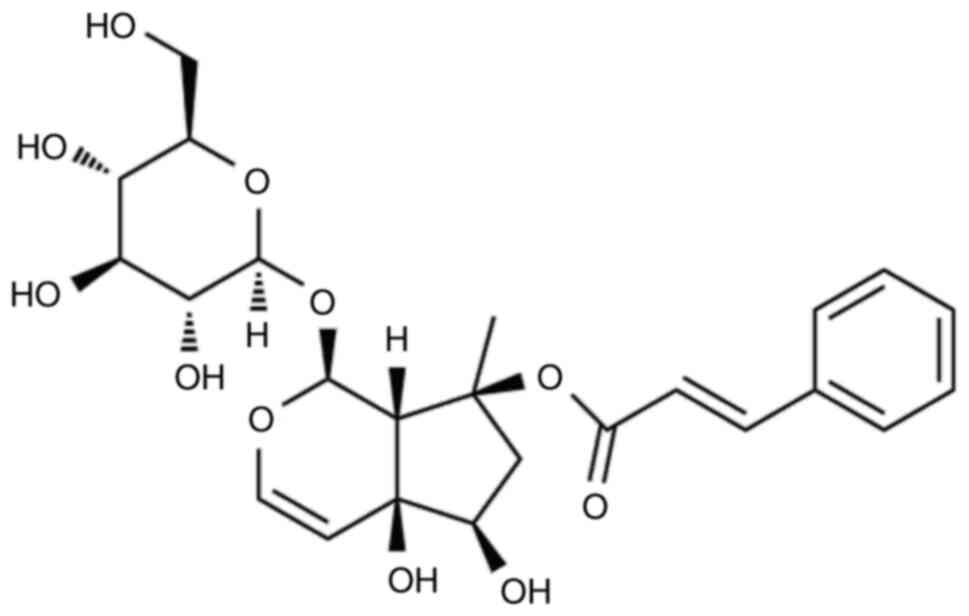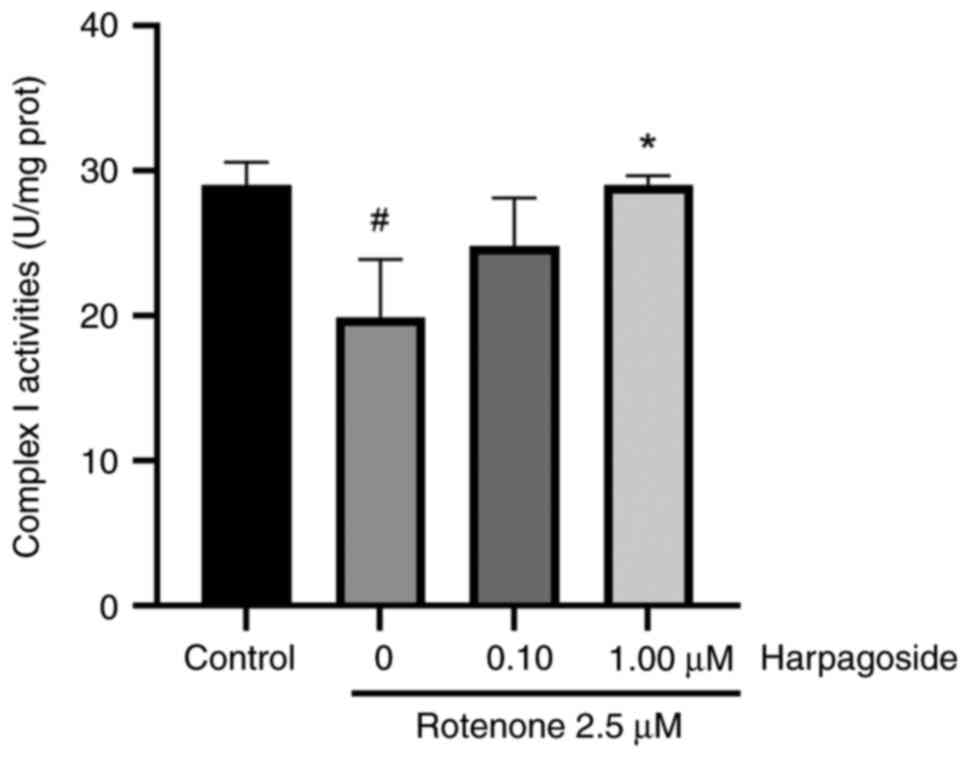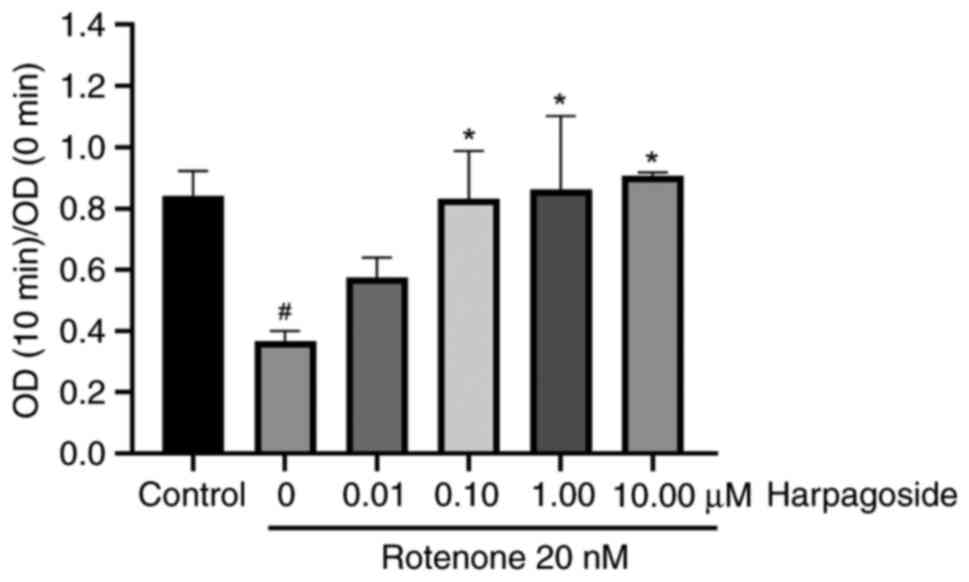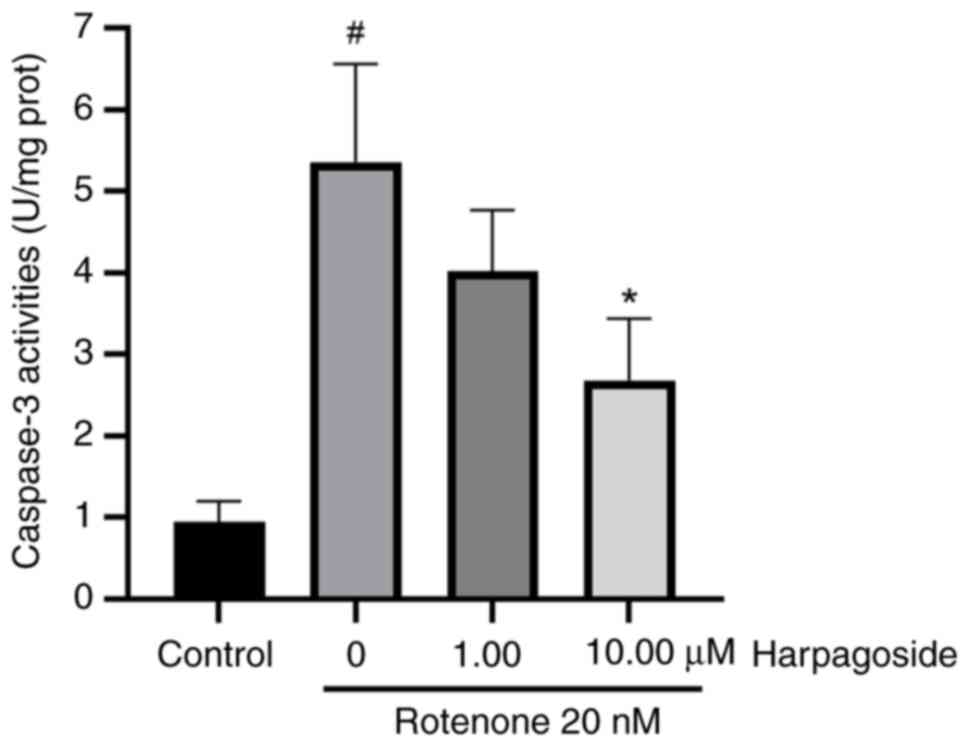|
1
|
Tolosa E, Garrido A, Scholz SW and Poewe
W: Challenges in the diagnosis of Parkinson's disease. Lancet
Neurol. 20:385–397. 2021.PubMed/NCBI View Article : Google Scholar
|
|
2
|
Zhou ZD, Yi LX, Wang DQ, Lim TM and Tan
EK: Role of dopamine in the pathophysiology of Parkinson's disease.
Transl Neurodegener. 12(44)2023.PubMed/NCBI View Article : Google Scholar
|
|
3
|
Norel R, Agurto C, Heisig S, Rice JJ,
Zhang H, Ostrand R, Wacnik PW, Ho BK, Ramos VL and Cecchi GA:
Speech-based characterization of dopamine replacement therapy in
people with Parkinson's disease. NPJ Parkinsons Dis.
6(12)2020.PubMed/NCBI View Article : Google Scholar
|
|
4
|
Yang X, Wang J, Zeng W, Zhang X, Yang X,
Xu Y, Xu Y and Cao X: Time-dependent alterations in the rat
nigrostriatal system after intrastriatal injection of fibrils
formed by α-Syn and tau fragments. Front Aging Neurosci.
14(1049418)2022.PubMed/NCBI View Article : Google Scholar
|
|
5
|
Sosnik R, Fahoum F, Katzir Z, Mirelman A
and Maidan I: Key shifts in frontoparietal network activity in
Parkinson's disease. NPJ Parkinsons Dis. 11(2)2025.PubMed/NCBI View Article : Google Scholar
|
|
6
|
Schapira AH: Mitochondria in the aetiology
and pathogenesis of Parkinson's disease. Lancet Neurol. 7:97–109.
2008.PubMed/NCBI View Article : Google Scholar
|
|
7
|
Schapira AH, Gu M, Taanman JW, Tabrizi SJ,
Seaton T, Cleeter M and Cooper JM: Mitochondria in the etiology and
pathogenesis of Parkinson's disease. Ann Neurol. 44 (3 Suppl
1):S89–S98. 1998.PubMed/NCBI View Article : Google Scholar
|
|
8
|
Ondo W: IPX066, a mixed
immediate/sustained-release levodopa preparation for Parkinson's
disease. Expert Opin Pharmacother. 15:2081–2085. 2014.PubMed/NCBI View Article : Google Scholar
|
|
9
|
Caronni S, Del Sorbo F, Barichella M,
Fothergill-Misbah N, Denne T, Laguna J, Urasa S, Dekker MCJ, Akpalu
A, Sarfo FS, et al: Mucuna pruriens to treat Parkinson's disease in
low-income countries: Recommendations and practical guidelines from
the farmer to clinical trials. Paving the way for future use in
clinical practice. Parkinsonism Relat Disord.
124(106983)2024.PubMed/NCBI View Article : Google Scholar
|
|
10
|
Kumari S, Gupta S, Sukhija R, Gurjar S,
Dubey SK and Taliyan R: Neuroprotective potential of Epigenetic
modulators, its regulation and therapeutic approaches for the
management of Parkinson's disease. Eur J Pharmacol.
985(177123)2024.PubMed/NCBI View Article : Google Scholar
|
|
11
|
Guo F, Qin X, Mao J, Xu Y and Xie J:
Potential protective effects of pungent flavor components in
neurodegenerative diseases. Molecules. 29(5700)2024.PubMed/NCBI View Article : Google Scholar
|
|
12
|
Filaferro M, Avallone R, Rustichelli C and
Vitale G: Characterization of walnut oil and evaluation of its
neuroprotective effects in an in vitro model of Parkinson's
disease. Molecules. 29(5718)2024.PubMed/NCBI View Article : Google Scholar
|
|
13
|
Kim JH, Huh E, Eo H, Kim JS, Kwon Y, Ju
IG, Choi Y, Yoon HJ, Son SR, Jang DS, et al: Tribuli Fructus
alleviates 1-methyl-4-phenyl 1,2,3,6-tetrahydropyridine
(MPTP)-induced Parkinson's disease by suppressing neuroinflammation
via JNK signaling. Metab Brain Dis. 40(69)2024.PubMed/NCBI View Article : Google Scholar
|
|
14
|
Natarajan K, Chandrasekaran R, Sundararaj
R, Joseph J and Asaithambi K: Neuroprotective assessment of
nutraceutical (Betanin) in neuroblastoma cell line SHSY-5Y: An
in-vitro and in-silico approach. Neurochem Res.
50(54)2024.PubMed/NCBI View Article : Google Scholar
|
|
15
|
Hvingelby VS and Pavese N: Surgical
advances in Parkinson's disease. Curr Neuropharmacol. 22:1033–1046.
2024.PubMed/NCBI View Article : Google Scholar
|
|
16
|
Rahimi Darehbagh R, Seyedoshohadaei SA,
Ramezani R and Rezaei N: Stem cell therapies for neurological
disorders: Current progress, challenges, and future perspectives.
Eur J Med Res. 29(386)2024.PubMed/NCBI View Article : Google Scholar
|
|
17
|
Huang S, Liu H, Lin Y, Liu M, Li Y, Mao H,
Zhang Z, Zhang Y, Ye P, Ding L, et al: Berberine protects against
NLRP3 inflammasome via ameliorating autophagic impairment in
MPTP-induced Parkinson's disease model. Front Pharmacol.
11(618787)2020.PubMed/NCBI View Article : Google Scholar
|
|
18
|
Vellingiri B, Chandrasekhar M, Sri Sabari
S, Gopalakrishnan AV, Narayanasamy A, Venkatesan D, Iyer M, Kesari
K and Dey A: Neurotoxicity of pesticides-A link to
neurodegeneration. Ecotoxicol Environ Saf.
243(113972)2022.PubMed/NCBI View Article : Google Scholar
|
|
19
|
Johnson ME and Bobrovskaya L: An update on
the rotenone models of Parkinson's disease: Their ability to
reproduce the features of clinical disease and model
gene-environment interactions. Neurotoxicology. 46:101–116.
2015.PubMed/NCBI View Article : Google Scholar
|
|
20
|
Betarbet R, Sherer TB, MacKenzie G,
Garcia-Osuna M, Panov AV and Greenamyre JT: Chronic systemic
pesticide exposure reproduces features of Parkinson's disease. Nat
Neurosci. 3:1301–1306. 2000.PubMed/NCBI View
Article : Google Scholar
|
|
21
|
Tao X, Zhang W, Chen C, Tao Y, Tao Y, Chen
Z and Zhang G: miR-101a-3p/ROCK2 axis regulates neuronal injury in
Parkinson's disease models. Aging (Albany NY). 16:8732–8746.
2024.PubMed/NCBI View Article : Google Scholar
|
|
22
|
Menchinskaya E, Chingizova E, Pislyagin E,
Likhatskaya G, Sabutski Y, Pelageev D, Polonik S and Aminin D:
Neuroprotective effect of 1,4-naphthoquinones in an in vitro model
of paraquat and 6-OHDA-induced neurotoxicity. Int J Mol Sci.
22(9933)2021.PubMed/NCBI View Article : Google Scholar
|
|
23
|
Verma A and Goyal A: Plumbagin's healing
effect on motor impairment in rotenone-toxified rodents. Curr
Neurovasc Res: Sep 3, 2024 (Epub ahead of print).
|
|
24
|
Olubodun-Obadun TG, Ishola IO, Folarin OR,
Oladoja FA, Gilbert TT, Aniekwensi IM, Bisiriyu A, Joseph-Iwebi NA,
Adebanjo FO, Olopade JO and Adeyemi OO: Cajanus cajan (L) Millsp
seeds extract prevents rotenone-induced motor- and non-motor
features of Parkinson disease in mice: Insight into mechanisms of
neuroprotection. J Ethnopharmacol. 322(117623)2024.PubMed/NCBI View Article : Google Scholar
|
|
25
|
Meng X, Xie W, Xu Q, Liang T, Xu X, Sun G
and Sun X: Neuroprotective effects of radix scrophulariae on
cerebral ischemia and reperfusion injury via MAPK pathways.
Molecules. 23(2401)2018.PubMed/NCBI View Article : Google Scholar
|
|
26
|
Lee HJ, Spandidos DA, Tsatsakis A, Margina
D, Izotov BN and Yang SH: Neuroprotective effects of Scrophularia
buergeriana extract against glutamate-induced toxicity in SH-SY5Y
cells. Int J Mol Sci. 43:2144–2152. 2019.PubMed/NCBI View Article : Google Scholar
|
|
27
|
Kim HL, Min DE, Lee SK, Choi BK and Lee
DR: Scrophularia buergeriana Extract (Brainon) attenuates
neuroinflammation in BV-2 microglia cells and promotes
neuroprotection in SH-SY5Y neuroblastoma cells. J Med Food.
26:328–341. 2023.PubMed/NCBI View Article : Google Scholar
|
|
28
|
Azadmehr A, Oghyanous KA, Hajiaghaee R,
Amirghofran Z and Azadbakht M: Antioxidant and neuroprotective
effects of Scrophularia striata extract against oxidative
stress-induced neurotoxicity. Cell Mol Neurobiol. 33:1135–1141.
2013.PubMed/NCBI View Article : Google Scholar
|
|
29
|
Salavati P, Ramezani M, Monsef-Esfahani
HR, Hajiagha R, Parsa M, Tavajohi S and Ostad SN: Neuroprotective
effect of total and sequential extract of scrophularia striata
boiss. in rat cerebellar granule neurons following
glutamate-induced neurotoxicity: An in-vitro study. Iran J Pharm
Res. 12:389–394. 2013.PubMed/NCBI
|
|
30
|
Wang K, Lou Y, Xu H, Zhong X and Huang Z:
Harpagide from Scrophularia protects rat cortical neurons from
oxygen-glucose deprivation and reoxygenation-induced injury by
decreasing endoplasmic reticulum stress. J Ethnopharmacol.
253(112614)2020.PubMed/NCBI View Article : Google Scholar
|
|
31
|
Chen C, Zhang H, Xu H, Xue R, Zheng Y, Wu
T and Lian Y: Harpagoside rescues the memory impairments in chronic
cerebral hypoperfusion rats by inhibiting PTEN activity. J
Alzheimers Dis. 63:445–455. 2018.PubMed/NCBI View Article : Google Scholar
|
|
32
|
Sun X, Xiong Z, Zhang Y, Meng Y, Xu G, Xia
Z, Li J, Zhang R, Ke Z, Xia Z and Hu Y: Harpagoside attenuates
MPTP/MPP(+) induced dopaminergic neurodegeneration and movement
disorder via elevating glial cell line-derived neurotrophic factor.
J Neurochem. 120:1072–1083. 2012.PubMed/NCBI View Article : Google Scholar
|
|
33
|
Dinda B, Dinda M, Kulsi G, Chakraborty A
and Dinda S: Therapeutic potentials of plant iridoids in
Alzheimer's and Parkinson's diseases: A review. Eur J Med Chem.
169:185–199. 2019.PubMed/NCBI View Article : Google Scholar
|
|
34
|
Wang Y, Shinoda Y, Cheng A, Kawahata I and
Fukunaga K: Epidermal fatty acid-binding protein 5 (FABP5)
involvement in alpha-synuclein-induced mitochondrial injury under
oxidative stress. Biomedicines. 9(110)2021.PubMed/NCBI View Article : Google Scholar
|
|
35
|
He L, Wang J, Yang Y, Li J and Tu H:
Mitochondrial sirtuins in Parkinson's disease. Neurochem Res.
47:1491–1502. 2022.PubMed/NCBI View Article : Google Scholar
|
|
36
|
Li W, Wang X, Liu T, Zhang Q, Cao J, Jiang
Y, Sun Q, Li C, Wang W and Wang Y: Harpagoside protects against
doxorubicin-induced cardiotoxicity via P53-parkin-mediated
mitophagy. Front Cell Dev Biol. 10(813370)2022.PubMed/NCBI View Article : Google Scholar
|
|
37
|
Tremblay RG, Sikorska M, Sandhu JK,
Lanthier P, Ribecco-Lutkiewicz M and Bani-Yaghoub M:
Differentiation of mouse Neuro 2A cells into dopamine neurons. J
Neurosci Methods. 186:60–67. 2010.PubMed/NCBI View Article : Google Scholar
|
|
38
|
Hergenhahn L, Padutsch N, Azawi S,
Weiskirchen R, Liehr T and Rincic M: Cytogenomic characterization
of murine neuroblastoma cell line neuro-2a and its two derivatives
neuro-2a TR-alpha and Neuro-2a TR-Beta. Cells.
13(1889)2024.PubMed/NCBI View Article : Google Scholar
|
|
39
|
Lei C, Wang J, Zhang X, Ge X, Zhao W, Li
X, Jiang W, Ma M, Wang Z, Sun S, et al: The wnt/pyruvate kinase,
muscle axis plays an essential role in the differentiation of mouse
neuroblastoma cells. Neurochem Int. 181(105901)2024.PubMed/NCBI View Article : Google Scholar
|
|
40
|
Kumar M and Katyal A: Data on retinoic
acid and reduced serum concentration induced differentiation of
Neuro-2a neuroblastoma cells. Data Brief. 21:2435–2440.
2018.PubMed/NCBI View Article : Google Scholar
|
|
41
|
Subramaniam SR and Chesselet MF:
Mitochondrial dysfunction and oxidative stress in Parkinson's
disease. Prog Neurobiol. 106-107:17–32. 2013.PubMed/NCBI View Article : Google Scholar
|
|
42
|
Chen R, Gu X and Wang X: α-Synuclein in
Parkinson's disease and advances in detection. Clin Chim Acta.
529:76–86. 2022.PubMed/NCBI View Article : Google Scholar
|
|
43
|
Bose A and Beal MF: Mitochondrial
dysfunction in Parkinson's disease. J Neurochem. 139:216–231.
2016.PubMed/NCBI View Article : Google Scholar
|
|
44
|
Perez MJ, Baden P and Deleidi M:
Progresses in both basic research and clinical trials of NAD+ in
Parkinson's disease. Mech Ageing Dev. 197(111499)2021.PubMed/NCBI View Article : Google Scholar
|
|
45
|
Yang Y and Lu B: Mitochondrial
morphogenesis, distribution, and Parkinson disease: Insights from
PINK1. J Neuropathol Exp Neurol. 68:953–963. 2009.PubMed/NCBI View Article : Google Scholar
|
|
46
|
Vila M, Ramonet D and Perier C:
Mitochondrial alterations in Parkinson's disease: new clues. J
Neurochem. 107:317–328. 2008.PubMed/NCBI View Article : Google Scholar
|
|
47
|
Casoli T, Lisa R, Fabbietti P and Conti F:
Analysis of mitochondrial DNA allelic changes in Parkinson's
disease: A preliminary study. Aging Clin Exp Res. 32:345–349.
2020.PubMed/NCBI View Article : Google Scholar
|
|
48
|
Henchcliffe C and Beal MF: Mitochondrial
biology and oxidative stress in Parkinson disease pathogenesis. Nat
Clin Pract Neurol. 4:600–609. 2008.PubMed/NCBI View Article : Google Scholar
|
|
49
|
Shen L and Dettmer U: Alpha-synuclein
effects on mitochondrial quality control in Parkinson's disease.
Biomolecules. 14(1649)2024.PubMed/NCBI View Article : Google Scholar
|
|
50
|
Yang JL, Weissman L, Bohr VA and Mattson
MP: Mitochondrial DNA damage and repair in neurodegenerative
disorders. DNA Repair (Amst). 7:1110–1120. 2008.PubMed/NCBI View Article : Google Scholar
|
|
51
|
Pathak RU and Davey GP: Complex I and
energy thresholds in the brain. Biochim Biophys Acta. 1777:777–782.
2008.PubMed/NCBI View Article : Google Scholar
|
|
52
|
Mazzio EA, Soliman YI and Soliman KF:
Variable toxicological response to the loss of OXPHOS through
1-methyl-4-phenylpyridinium-induced mitochondrial damage and anoxia
in diverse neural immortal cell lines. Cell Biol Toxicol.
26:527–539. 2010.PubMed/NCBI View Article : Google Scholar
|
|
53
|
Wong CK, Yeung HY, Mak NK, DiMattia GE,
Chan DK and Wagner GF: Effects of dibutyryl cAMP on stanniocalcin
and stanniocalcin-related protein mRNA expression in neuroblastoma
cells. J Endocrinol. 173:199–209. 2002.PubMed/NCBI View Article : Google Scholar
|
|
54
|
Ferrari E, Cardinale A, Picconi B and
Gardoni F: From cell lines to pluripotent stem cells for modelling
Parkinson's disease. J Neurosci Methods. 340(108741)2020.PubMed/NCBI View Article : Google Scholar
|
|
55
|
LePage KT, Dickey RW, Gerwick WH, Jester
EL and Murray TF: On the use of neuro-2a neuroblastoma cells versus
intact neurons in primary culture for neurotoxicity studies. Crit
Rev Neurobiol. 17:27–50. 2005.PubMed/NCBI View Article : Google Scholar
|
|
56
|
Agafonova I, Chingizova E, Chaikina E,
Menchinskaya E, Kozlovskiy S, Likhatskaya G, Sabutski Y, Polonik S,
Aminin D and Pislyagin E: Protection activity of
1,4-naphthoquinones in rotenone-induced models of neurotoxicity.
Mar Drugs. 22(62)2024.PubMed/NCBI View Article : Google Scholar
|
|
57
|
Xia N, Madore V, Albalakhi A, Lin S,
Stimpson T, Xu Y, Schwarzschild MA and Bakshi R:
Microglia-dependent neuroprotective effects of 4-octyl itaconate
against rotenone-and MPP+-induced neurotoxicity in Parkinson's
disease. Sci Rep. 13(15539)2023.PubMed/NCBI View Article : Google Scholar
|
|
58
|
Swarnkar S, Goswami P, Kamat PK, Gupta S,
Patro IK, Singh S and Nath C: Rotenone-induced apoptosis and role
of calcium: A study on Neuro-2a cells. Arch Toxicol. 86:1387–1397.
2012.PubMed/NCBI View Article : Google Scholar
|
|
59
|
Xiong Z, Wang S and Lang J: Inhibitory
effects of deguelin on the viability of neuro-2A cells. Chin
Pharmacist. 17:1793–1796. 2014.(In Chinese).
|
|
60
|
Caboni P, Sherer TB, Zhang N, Taylor G, Na
HM, Greenamyre JT and Casida JE: Rotenone, deguelin, their
metabolites, and the rat model of Parkinson's disease. Chem Res
Toxicol. 17:1540–1548. 2004.PubMed/NCBI View Article : Google Scholar
|
|
61
|
Sherer TB, Betarbet R, Testa CM, Seo BB,
Richardson JR, Kim JH, Miller GW, Yagi T, Matsuno-Yagi A and
Greenamyre JT: Mechanism of toxicity in rotenone models of
Parkinson's disease. J Neurosci. 23:10756–10764. 2003.PubMed/NCBI View Article : Google Scholar
|
|
62
|
Kondamudi N, Turner MW and McDougal OM:
Harpagoside content in devil's claw extracts. Nat Prod Commun.
11:1215–1216. 2016.PubMed/NCBI
|
|
63
|
Schaffer LF, Peroza LR, Boligon AA,
Athayde ML, Alves SH, Fachinetto R and Wagner C: Harpagophytum
procumbens prevents oxidative stress and loss of cell viability in
vitro. Neurochem Res. 38:2256–2267. 2013.PubMed/NCBI View Article : Google Scholar
|
|
64
|
Ferrante C, Recinella L, Locatelli M,
Guglielmi P, Secci D, Leporini L, Chiavaroli A, Leone S, Martinotti
S, Brunetti L, et al: Protective effects induced by
microwave-assisted aqueous harpagophytum extract on rat cortex
synaptosomes challenged with amyloid β-peptide. Phytother Res.
31:1257–1264. 2017.PubMed/NCBI View Article : Google Scholar
|
|
65
|
Hong JY, Kim H, Yeo C, Lee J, Jeon WJ, Lee
YJ and Ha IH: Epidural injection of harpagoside for the recovery of
rats with lumbar spinal stenosis. Cells. 12(2281)2023.PubMed/NCBI View Article : Google Scholar
|
|
66
|
Kim SR, Lee KY, Koo KA, Sung SH, Lee NG,
Kim J and Kim YC: Four new neuroprotective iridoid glycosides from
Scrophularia buergeriana roots. J Nat Prod. 65:1696–1699.
2002.PubMed/NCBI View Article : Google Scholar
|
|
67
|
Jeong EJ, Lee KY, Kim SH, Sung SH and Kim
YC: Cognitive-enhancing and antioxidant activities of iridoid
glycosides from Scrophularia buergeriana in scopolamine-treated
mice. Eur J Pharmacol. 588:78–84. 2008.PubMed/NCBI View Article : Google Scholar
|
|
68
|
Li J, Ding X, Zhang R, Jiang W, Sun X, Xia
Z, Wang X, Wu E, Zhang Y and Hu Y: Harpagoside ameliorates the
amyloid-β-induced cognitive impairment in rats via up-regulating
BDNF expression and MAPK/PI3K pathways. Neuroscience. 303:103–114.
2015.PubMed/NCBI View Article : Google Scholar
|
|
69
|
Hao RJ, Yu GR, Qin XD and Lu YW:
Harpagoside alleviates neuronal damage caused by neuroinflammation
via suppressing TLR4/MyD88/NF-κB pathway. Chin Tradit Herbal Drugs.
54:4202–4213. 2023.(In Chinese).
|
|
70
|
Huang TH, Tran VH, Duke RK, Tan S,
Chrubasik S, Roufogalis BD and Duke CC: Harpagoside suppresses
lipopolysaccharide-induced iNOS and COX-2 expression through
inhibition of NF-kappa B activation. J Ethnopharmacol. 104:149–155.
2006.PubMed/NCBI View Article : Google Scholar
|















